Osteoporosis Report: AHRQ Guidelines, Literature Review, and PICO
VerifiedAdded on 2022/08/17
|12
|3003
|9
Report
AI Summary
This report examines osteoporosis, a global disorder characterized by decreased bone mass, increased fragility, and fracture risk. It begins with an introduction to osteoporosis, its prevalence, and the associated economic burden, highlighting the role of guidelines like those from the American Association of Clinical Endocrinologists (AACE) in mitigating risks. The report then presents a research question developed using the PICO model, focusing on the effectiveness of alternative treatments versus medical therapy for managing osteoporosis and controlling spasticity. A detailed search strategy is outlined, specifying data sources, keywords, and inclusion/exclusion criteria for the literature review. The literature review summarizes key findings from recent studies, including the role of the CX3CL1/CX3CR1 axis in bone mineral density reduction, bone density testing and lifestyle approaches, and the relationship between bone mineral density and multiple sclerosis. The report also includes a summary of a Cochrane review and provides recommendations based on AACE guidelines for patient management, including pharmacologic therapies and lifestyle changes. The report concludes by emphasizing the importance of bone analysis in cases of multiple sclerosis and the USPSTF's recommendations for osteoporosis screening.
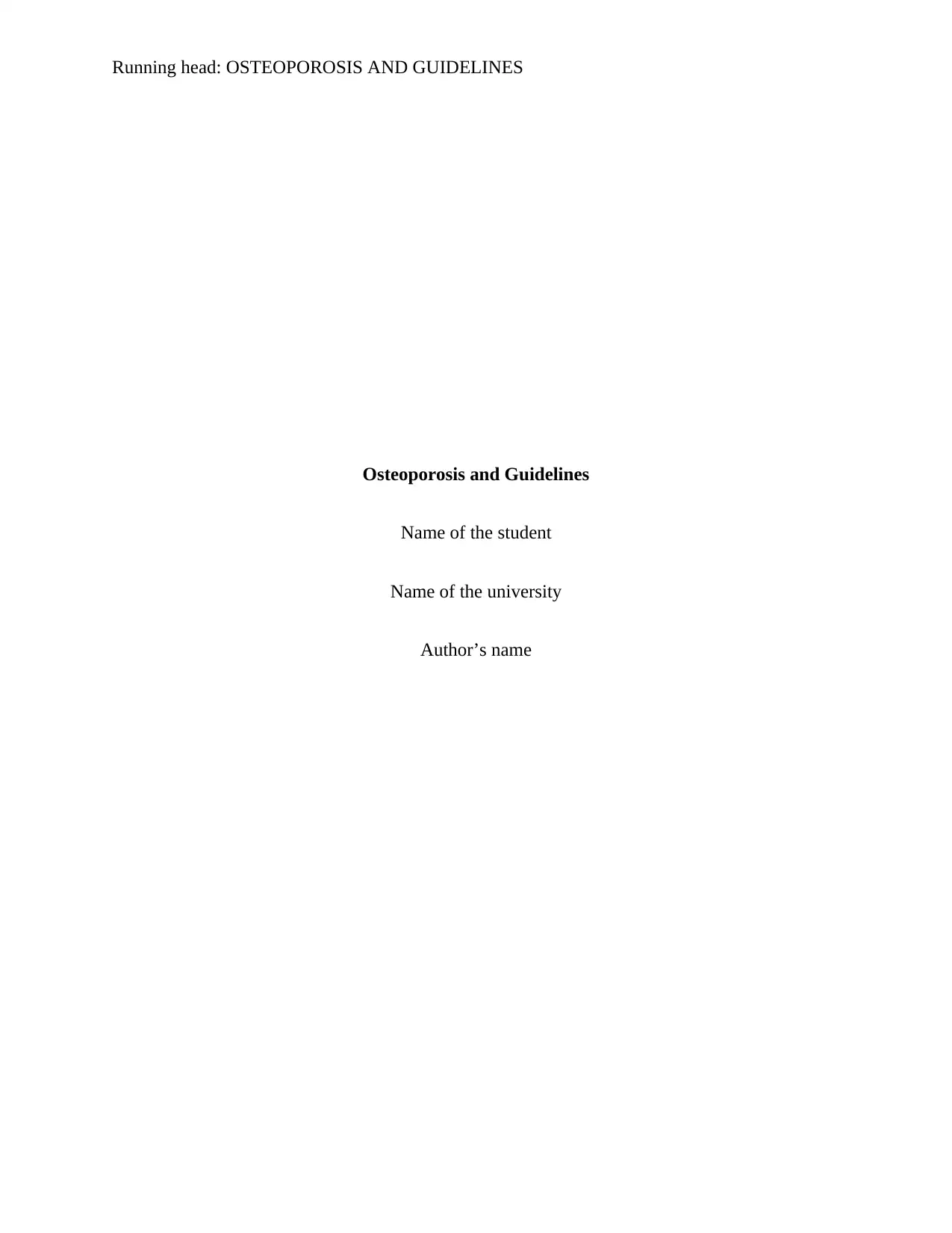
Running head: OSTEOPOROSIS AND GUIDELINES
Osteoporosis and Guidelines
Name of the student
Name of the university
Author’s name
Osteoporosis and Guidelines
Name of the student
Name of the university
Author’s name
Paraphrase This Document
Need a fresh take? Get an instant paraphrase of this document with our AI Paraphraser
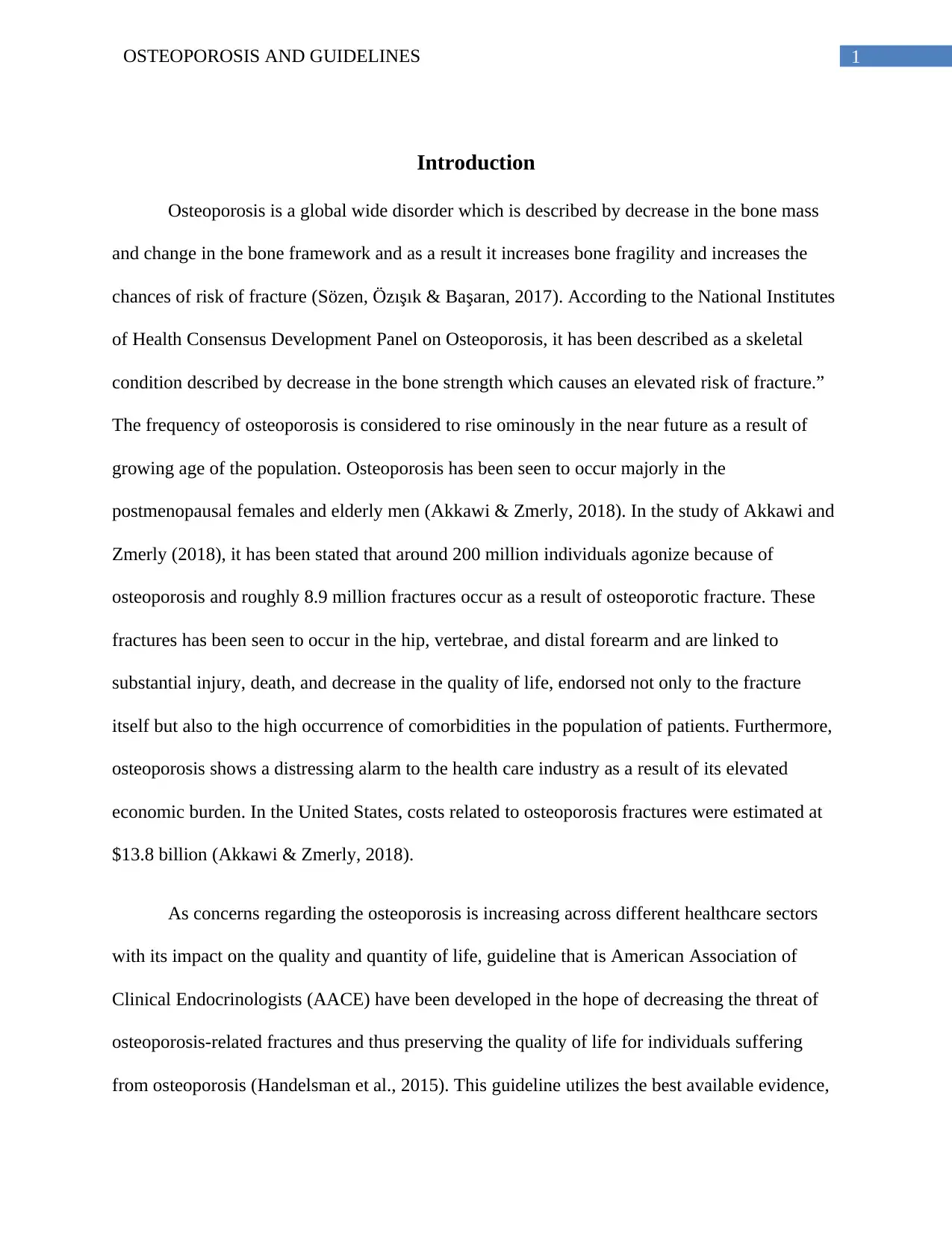
1OSTEOPOROSIS AND GUIDELINES
Introduction
Osteoporosis is a global wide disorder which is described by decrease in the bone mass
and change in the bone framework and as a result it increases bone fragility and increases the
chances of risk of fracture (Sözen, Özışık & Başaran, 2017). According to the National Institutes
of Health Consensus Development Panel on Osteoporosis, it has been described as a skeletal
condition described by decrease in the bone strength which causes an elevated risk of fracture.”
The frequency of osteoporosis is considered to rise ominously in the near future as a result of
growing age of the population. Osteoporosis has been seen to occur majorly in the
postmenopausal females and elderly men (Akkawi & Zmerly, 2018). In the study of Akkawi and
Zmerly (2018), it has been stated that around 200 million individuals agonize because of
osteoporosis and roughly 8.9 million fractures occur as a result of osteoporotic fracture. These
fractures has been seen to occur in the hip, vertebrae, and distal forearm and are linked to
substantial injury, death, and decrease in the quality of life, endorsed not only to the fracture
itself but also to the high occurrence of comorbidities in the population of patients. Furthermore,
osteoporosis shows a distressing alarm to the health care industry as a result of its elevated
economic burden. In the United States, costs related to osteoporosis fractures were estimated at
$13.8 billion (Akkawi & Zmerly, 2018).
As concerns regarding the osteoporosis is increasing across different healthcare sectors
with its impact on the quality and quantity of life, guideline that is American Association of
Clinical Endocrinologists (AACE) have been developed in the hope of decreasing the threat of
osteoporosis-related fractures and thus preserving the quality of life for individuals suffering
from osteoporosis (Handelsman et al., 2015). This guideline utilizes the best available evidence,
Introduction
Osteoporosis is a global wide disorder which is described by decrease in the bone mass
and change in the bone framework and as a result it increases bone fragility and increases the
chances of risk of fracture (Sözen, Özışık & Başaran, 2017). According to the National Institutes
of Health Consensus Development Panel on Osteoporosis, it has been described as a skeletal
condition described by decrease in the bone strength which causes an elevated risk of fracture.”
The frequency of osteoporosis is considered to rise ominously in the near future as a result of
growing age of the population. Osteoporosis has been seen to occur majorly in the
postmenopausal females and elderly men (Akkawi & Zmerly, 2018). In the study of Akkawi and
Zmerly (2018), it has been stated that around 200 million individuals agonize because of
osteoporosis and roughly 8.9 million fractures occur as a result of osteoporotic fracture. These
fractures has been seen to occur in the hip, vertebrae, and distal forearm and are linked to
substantial injury, death, and decrease in the quality of life, endorsed not only to the fracture
itself but also to the high occurrence of comorbidities in the population of patients. Furthermore,
osteoporosis shows a distressing alarm to the health care industry as a result of its elevated
economic burden. In the United States, costs related to osteoporosis fractures were estimated at
$13.8 billion (Akkawi & Zmerly, 2018).
As concerns regarding the osteoporosis is increasing across different healthcare sectors
with its impact on the quality and quantity of life, guideline that is American Association of
Clinical Endocrinologists (AACE) have been developed in the hope of decreasing the threat of
osteoporosis-related fractures and thus preserving the quality of life for individuals suffering
from osteoporosis (Handelsman et al., 2015). This guideline utilizes the best available evidence,
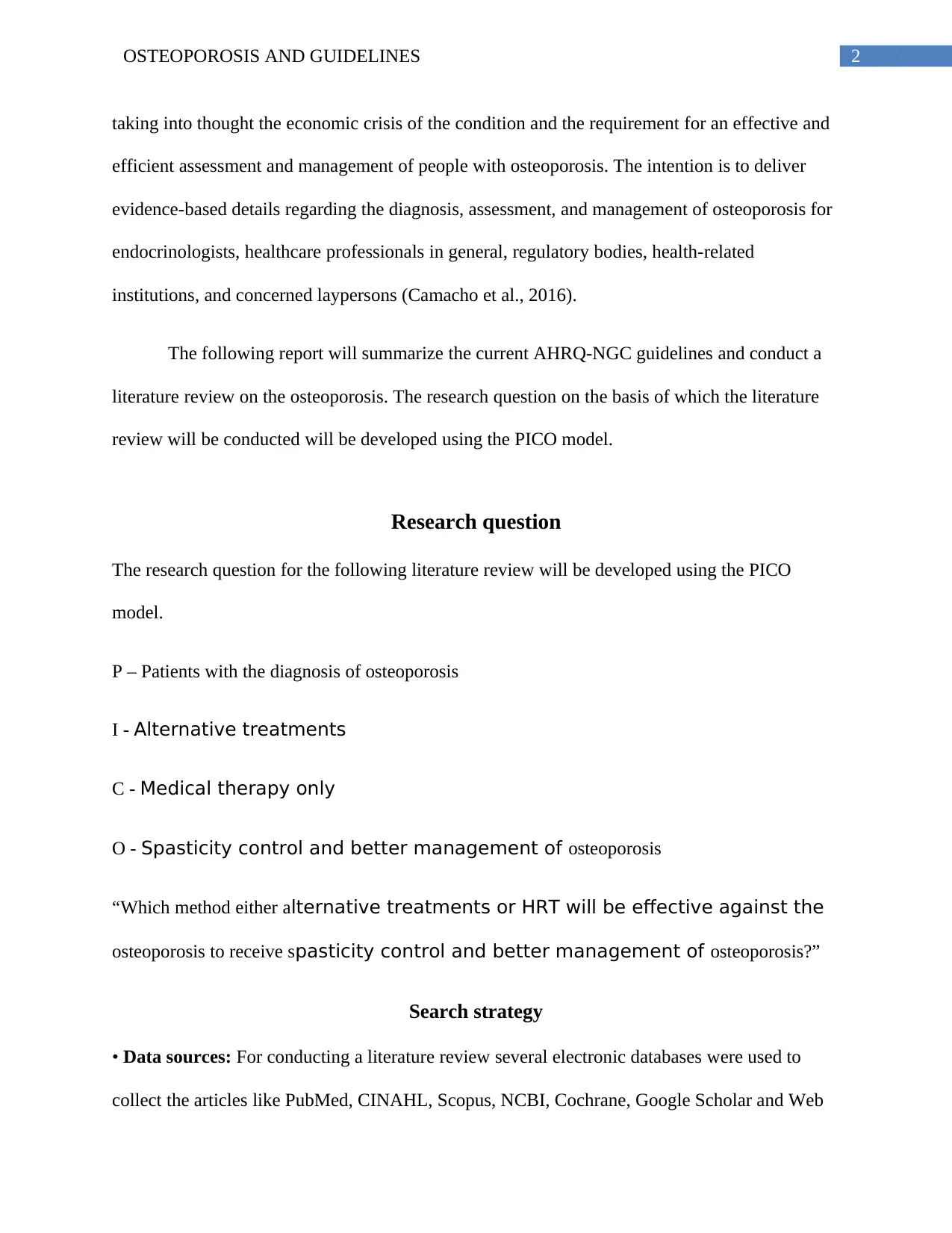
2OSTEOPOROSIS AND GUIDELINES
taking into thought the economic crisis of the condition and the requirement for an effective and
efficient assessment and management of people with osteoporosis. The intention is to deliver
evidence-based details regarding the diagnosis, assessment, and management of osteoporosis for
endocrinologists, healthcare professionals in general, regulatory bodies, health-related
institutions, and concerned laypersons (Camacho et al., 2016).
The following report will summarize the current AHRQ-NGC guidelines and conduct a
literature review on the osteoporosis. The research question on the basis of which the literature
review will be conducted will be developed using the PICO model.
Research question
The research question for the following literature review will be developed using the PICO
model.
P – Patients with the diagnosis of osteoporosis
I - Alternative treatments
C - Medical therapy only
O - Spasticity control and better management of osteoporosis
“Which method either alternative treatments or HRT will be effective against the
osteoporosis to receive spasticity control and better management of osteoporosis?”
Search strategy
• Data sources: For conducting a literature review several electronic databases were used to
collect the articles like PubMed, CINAHL, Scopus, NCBI, Cochrane, Google Scholar and Web
taking into thought the economic crisis of the condition and the requirement for an effective and
efficient assessment and management of people with osteoporosis. The intention is to deliver
evidence-based details regarding the diagnosis, assessment, and management of osteoporosis for
endocrinologists, healthcare professionals in general, regulatory bodies, health-related
institutions, and concerned laypersons (Camacho et al., 2016).
The following report will summarize the current AHRQ-NGC guidelines and conduct a
literature review on the osteoporosis. The research question on the basis of which the literature
review will be conducted will be developed using the PICO model.
Research question
The research question for the following literature review will be developed using the PICO
model.
P – Patients with the diagnosis of osteoporosis
I - Alternative treatments
C - Medical therapy only
O - Spasticity control and better management of osteoporosis
“Which method either alternative treatments or HRT will be effective against the
osteoporosis to receive spasticity control and better management of osteoporosis?”
Search strategy
• Data sources: For conducting a literature review several electronic databases were used to
collect the articles like PubMed, CINAHL, Scopus, NCBI, Cochrane, Google Scholar and Web
⊘ This is a preview!⊘
Do you want full access?
Subscribe today to unlock all pages.

Trusted by 1+ million students worldwide
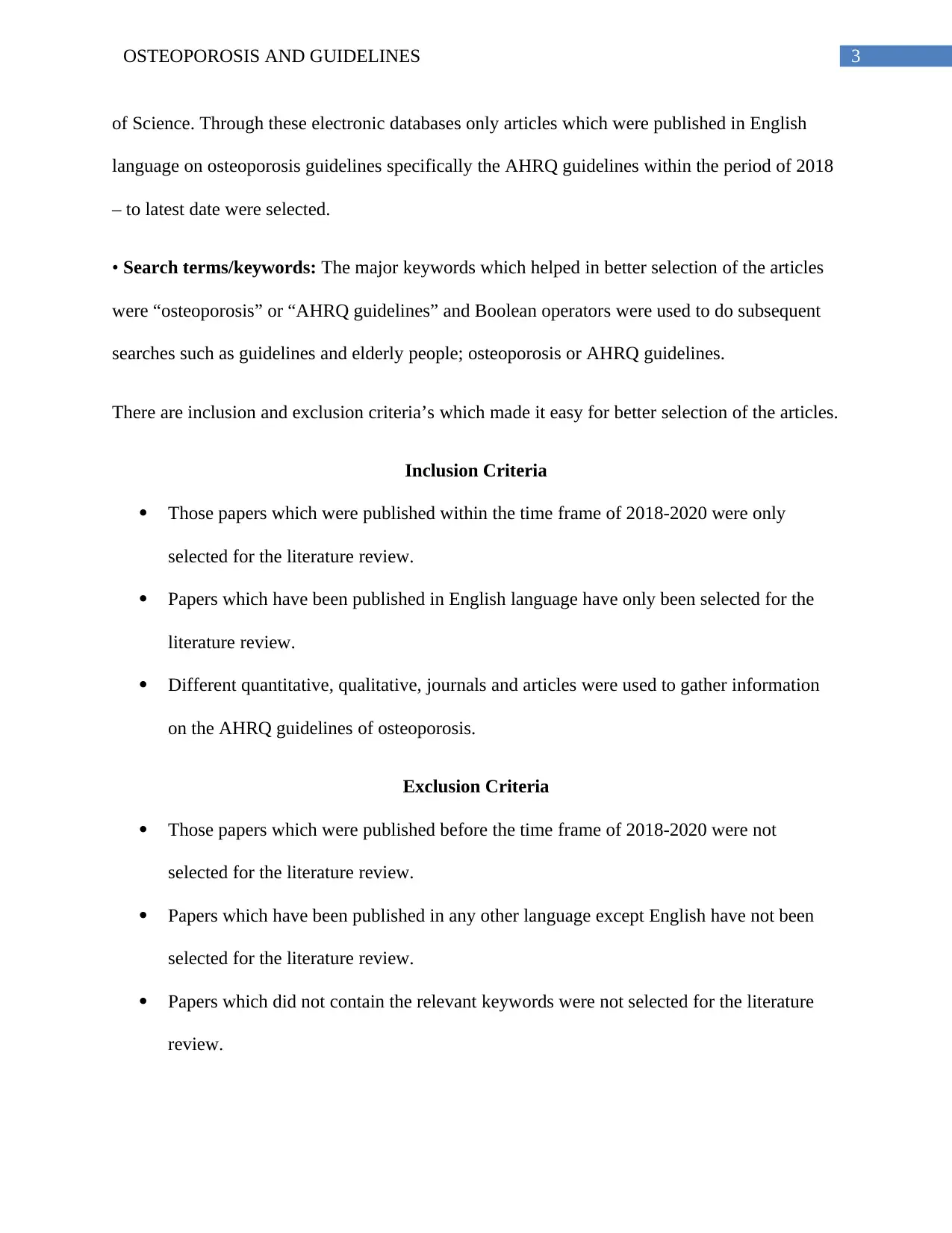
3OSTEOPOROSIS AND GUIDELINES
of Science. Through these electronic databases only articles which were published in English
language on osteoporosis guidelines specifically the AHRQ guidelines within the period of 2018
– to latest date were selected.
• Search terms/keywords: The major keywords which helped in better selection of the articles
were “osteoporosis” or “AHRQ guidelines” and Boolean operators were used to do subsequent
searches such as guidelines and elderly people; osteoporosis or AHRQ guidelines.
There are inclusion and exclusion criteria’s which made it easy for better selection of the articles.
Inclusion Criteria
Those papers which were published within the time frame of 2018-2020 were only
selected for the literature review.
Papers which have been published in English language have only been selected for the
literature review.
Different quantitative, qualitative, journals and articles were used to gather information
on the AHRQ guidelines of osteoporosis.
Exclusion Criteria
Those papers which were published before the time frame of 2018-2020 were not
selected for the literature review.
Papers which have been published in any other language except English have not been
selected for the literature review.
Papers which did not contain the relevant keywords were not selected for the literature
review.
of Science. Through these electronic databases only articles which were published in English
language on osteoporosis guidelines specifically the AHRQ guidelines within the period of 2018
– to latest date were selected.
• Search terms/keywords: The major keywords which helped in better selection of the articles
were “osteoporosis” or “AHRQ guidelines” and Boolean operators were used to do subsequent
searches such as guidelines and elderly people; osteoporosis or AHRQ guidelines.
There are inclusion and exclusion criteria’s which made it easy for better selection of the articles.
Inclusion Criteria
Those papers which were published within the time frame of 2018-2020 were only
selected for the literature review.
Papers which have been published in English language have only been selected for the
literature review.
Different quantitative, qualitative, journals and articles were used to gather information
on the AHRQ guidelines of osteoporosis.
Exclusion Criteria
Those papers which were published before the time frame of 2018-2020 were not
selected for the literature review.
Papers which have been published in any other language except English have not been
selected for the literature review.
Papers which did not contain the relevant keywords were not selected for the literature
review.
Paraphrase This Document
Need a fresh take? Get an instant paraphrase of this document with our AI Paraphraser
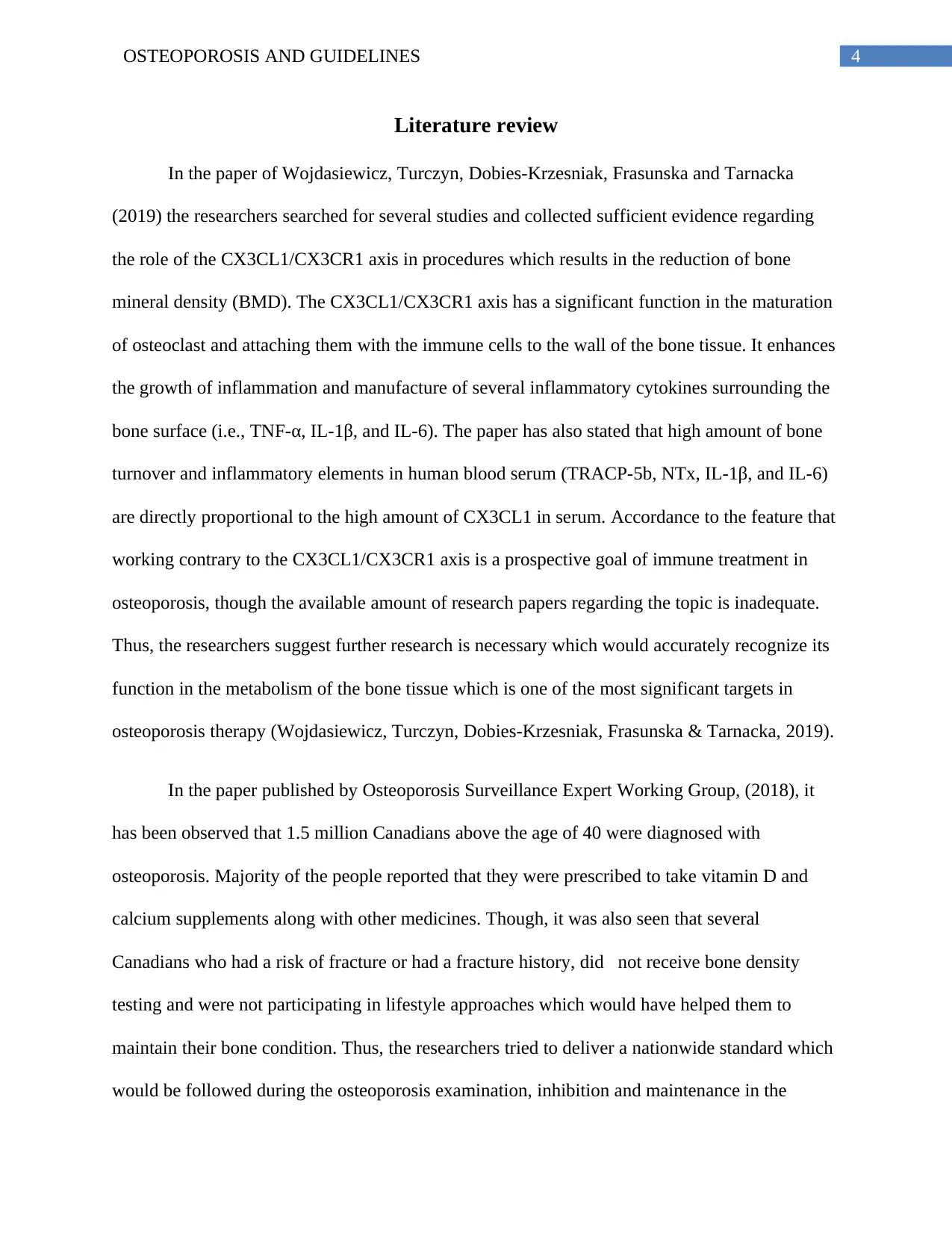
4OSTEOPOROSIS AND GUIDELINES
Literature review
In the paper of Wojdasiewicz, Turczyn, Dobies-Krzesniak, Frasunska and Tarnacka
(2019) the researchers searched for several studies and collected sufficient evidence regarding
the role of the CX3CL1/CX3CR1 axis in procedures which results in the reduction of bone
mineral density (BMD). The CX3CL1/CX3CR1 axis has a significant function in the maturation
of osteoclast and attaching them with the immune cells to the wall of the bone tissue. It enhances
the growth of inflammation and manufacture of several inflammatory cytokines surrounding the
bone surface (i.e., TNF-α, IL-1β, and IL-6). The paper has also stated that high amount of bone
turnover and inflammatory elements in human blood serum (TRACP-5b, NTx, IL-1β, and IL-6)
are directly proportional to the high amount of CX3CL1 in serum. Accordance to the feature that
working contrary to the CX3CL1/CX3CR1 axis is a prospective goal of immune treatment in
osteoporosis, though the available amount of research papers regarding the topic is inadequate.
Thus, the researchers suggest further research is necessary which would accurately recognize its
function in the metabolism of the bone tissue which is one of the most significant targets in
osteoporosis therapy (Wojdasiewicz, Turczyn, Dobies-Krzesniak, Frasunska & Tarnacka, 2019).
In the paper published by Osteoporosis Surveillance Expert Working Group, (2018), it
has been observed that 1.5 million Canadians above the age of 40 were diagnosed with
osteoporosis. Majority of the people reported that they were prescribed to take vitamin D and
calcium supplements along with other medicines. Though, it was also seen that several
Canadians who had a risk of fracture or had a fracture history, did not receive bone density
testing and were not participating in lifestyle approaches which would have helped them to
maintain their bone condition. Thus, the researchers tried to deliver a nationwide standard which
would be followed during the osteoporosis examination, inhibition and maintenance in the
Literature review
In the paper of Wojdasiewicz, Turczyn, Dobies-Krzesniak, Frasunska and Tarnacka
(2019) the researchers searched for several studies and collected sufficient evidence regarding
the role of the CX3CL1/CX3CR1 axis in procedures which results in the reduction of bone
mineral density (BMD). The CX3CL1/CX3CR1 axis has a significant function in the maturation
of osteoclast and attaching them with the immune cells to the wall of the bone tissue. It enhances
the growth of inflammation and manufacture of several inflammatory cytokines surrounding the
bone surface (i.e., TNF-α, IL-1β, and IL-6). The paper has also stated that high amount of bone
turnover and inflammatory elements in human blood serum (TRACP-5b, NTx, IL-1β, and IL-6)
are directly proportional to the high amount of CX3CL1 in serum. Accordance to the feature that
working contrary to the CX3CL1/CX3CR1 axis is a prospective goal of immune treatment in
osteoporosis, though the available amount of research papers regarding the topic is inadequate.
Thus, the researchers suggest further research is necessary which would accurately recognize its
function in the metabolism of the bone tissue which is one of the most significant targets in
osteoporosis therapy (Wojdasiewicz, Turczyn, Dobies-Krzesniak, Frasunska & Tarnacka, 2019).
In the paper published by Osteoporosis Surveillance Expert Working Group, (2018), it
has been observed that 1.5 million Canadians above the age of 40 were diagnosed with
osteoporosis. Majority of the people reported that they were prescribed to take vitamin D and
calcium supplements along with other medicines. Though, it was also seen that several
Canadians who had a risk of fracture or had a fracture history, did not receive bone density
testing and were not participating in lifestyle approaches which would have helped them to
maintain their bone condition. Thus, the researchers tried to deliver a nationwide standard which
would be followed during the osteoporosis examination, inhibition and maintenance in the
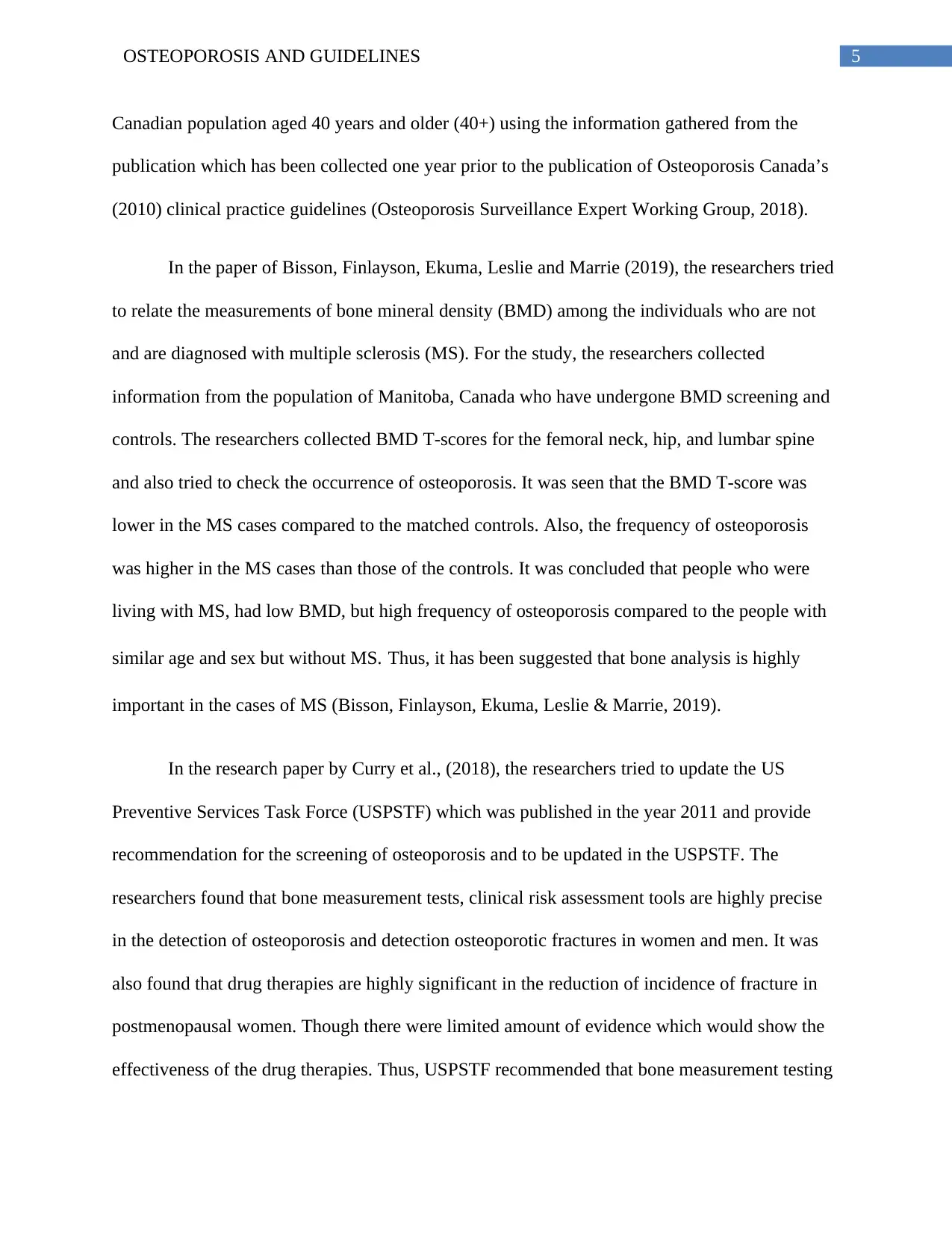
5OSTEOPOROSIS AND GUIDELINES
Canadian population aged 40 years and older (40+) using the information gathered from the
publication which has been collected one year prior to the publication of Osteoporosis Canada’s
(2010) clinical practice guidelines (Osteoporosis Surveillance Expert Working Group, 2018).
In the paper of Bisson, Finlayson, Ekuma, Leslie and Marrie (2019), the researchers tried
to relate the measurements of bone mineral density (BMD) among the individuals who are not
and are diagnosed with multiple sclerosis (MS). For the study, the researchers collected
information from the population of Manitoba, Canada who have undergone BMD screening and
controls. The researchers collected BMD T-scores for the femoral neck, hip, and lumbar spine
and also tried to check the occurrence of osteoporosis. It was seen that the BMD T-score was
lower in the MS cases compared to the matched controls. Also, the frequency of osteoporosis
was higher in the MS cases than those of the controls. It was concluded that people who were
living with MS, had low BMD, but high frequency of osteoporosis compared to the people with
similar age and sex but without MS. Thus, it has been suggested that bone analysis is highly
important in the cases of MS (Bisson, Finlayson, Ekuma, Leslie & Marrie, 2019).
In the research paper by Curry et al., (2018), the researchers tried to update the US
Preventive Services Task Force (USPSTF) which was published in the year 2011 and provide
recommendation for the screening of osteoporosis and to be updated in the USPSTF. The
researchers found that bone measurement tests, clinical risk assessment tools are highly precise
in the detection of osteoporosis and detection osteoporotic fractures in women and men. It was
also found that drug therapies are highly significant in the reduction of incidence of fracture in
postmenopausal women. Though there were limited amount of evidence which would show the
effectiveness of the drug therapies. Thus, USPSTF recommended that bone measurement testing
Canadian population aged 40 years and older (40+) using the information gathered from the
publication which has been collected one year prior to the publication of Osteoporosis Canada’s
(2010) clinical practice guidelines (Osteoporosis Surveillance Expert Working Group, 2018).
In the paper of Bisson, Finlayson, Ekuma, Leslie and Marrie (2019), the researchers tried
to relate the measurements of bone mineral density (BMD) among the individuals who are not
and are diagnosed with multiple sclerosis (MS). For the study, the researchers collected
information from the population of Manitoba, Canada who have undergone BMD screening and
controls. The researchers collected BMD T-scores for the femoral neck, hip, and lumbar spine
and also tried to check the occurrence of osteoporosis. It was seen that the BMD T-score was
lower in the MS cases compared to the matched controls. Also, the frequency of osteoporosis
was higher in the MS cases than those of the controls. It was concluded that people who were
living with MS, had low BMD, but high frequency of osteoporosis compared to the people with
similar age and sex but without MS. Thus, it has been suggested that bone analysis is highly
important in the cases of MS (Bisson, Finlayson, Ekuma, Leslie & Marrie, 2019).
In the research paper by Curry et al., (2018), the researchers tried to update the US
Preventive Services Task Force (USPSTF) which was published in the year 2011 and provide
recommendation for the screening of osteoporosis and to be updated in the USPSTF. The
researchers found that bone measurement tests, clinical risk assessment tools are highly precise
in the detection of osteoporosis and detection osteoporotic fractures in women and men. It was
also found that drug therapies are highly significant in the reduction of incidence of fracture in
postmenopausal women. Though there were limited amount of evidence which would show the
effectiveness of the drug therapies. Thus, USPSTF recommended that bone measurement testing
⊘ This is a preview!⊘
Do you want full access?
Subscribe today to unlock all pages.

Trusted by 1+ million students worldwide
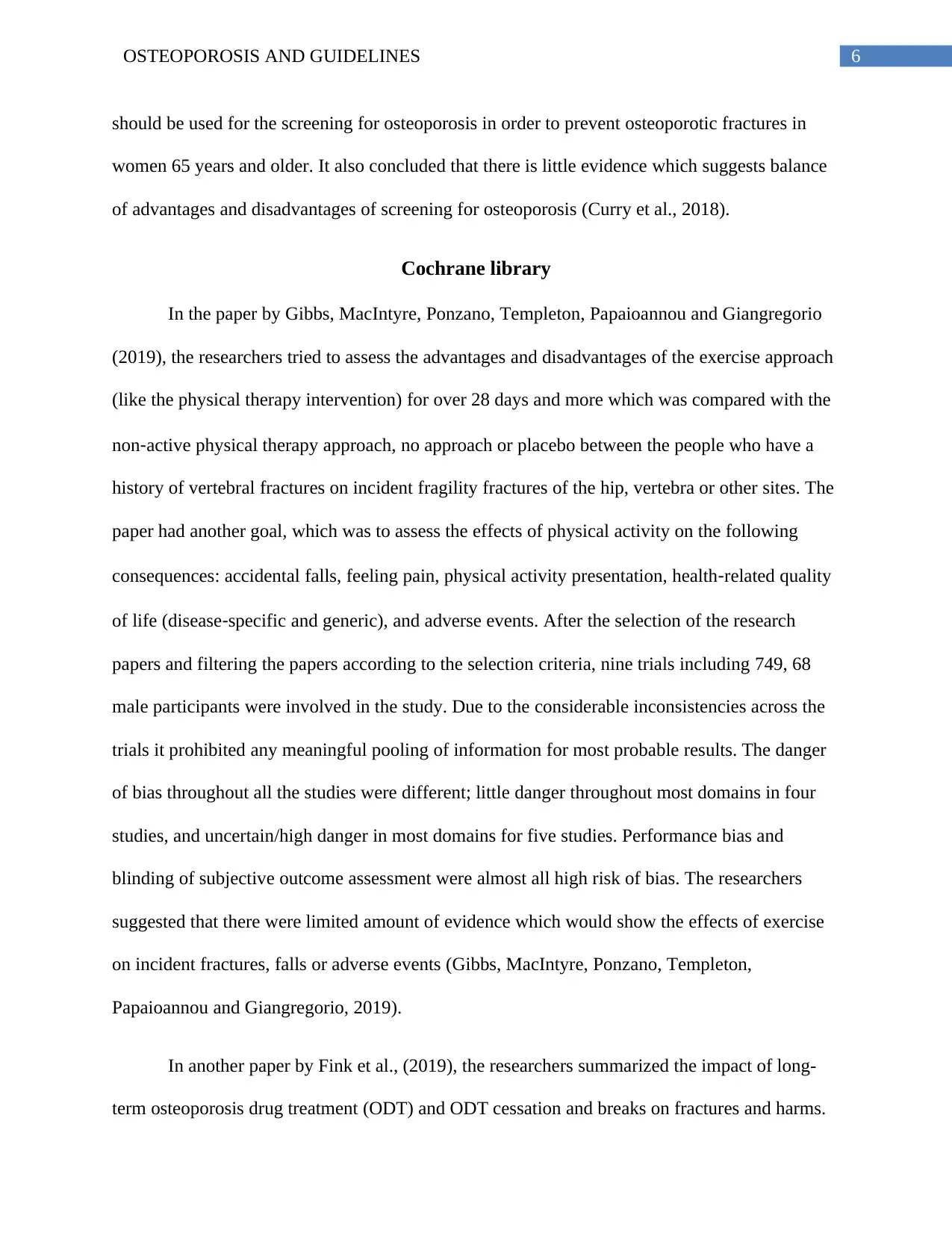
6OSTEOPOROSIS AND GUIDELINES
should be used for the screening for osteoporosis in order to prevent osteoporotic fractures in
women 65 years and older. It also concluded that there is little evidence which suggests balance
of advantages and disadvantages of screening for osteoporosis (Curry et al., 2018).
Cochrane library
In the paper by Gibbs, MacIntyre, Ponzano, Templeton, Papaioannou and Giangregorio
(2019), the researchers tried to assess the advantages and disadvantages of the exercise approach
(like the physical therapy intervention) for over 28 days and more which was compared with the
non‐active physical therapy approach, no approach or placebo between the people who have a
history of vertebral fractures on incident fragility fractures of the hip, vertebra or other sites. The
paper had another goal, which was to assess the effects of physical activity on the following
consequences: accidental falls, feeling pain, physical activity presentation, health‐related quality
of life (disease‐specific and generic), and adverse events. After the selection of the research
papers and filtering the papers according to the selection criteria, nine trials including 749, 68
male participants were involved in the study. Due to the considerable inconsistencies across the
trials it prohibited any meaningful pooling of information for most probable results. The danger
of bias throughout all the studies were different; little danger throughout most domains in four
studies, and uncertain/high danger in most domains for five studies. Performance bias and
blinding of subjective outcome assessment were almost all high risk of bias. The researchers
suggested that there were limited amount of evidence which would show the effects of exercise
on incident fractures, falls or adverse events (Gibbs, MacIntyre, Ponzano, Templeton,
Papaioannou and Giangregorio, 2019).
In another paper by Fink et al., (2019), the researchers summarized the impact of long-
term osteoporosis drug treatment (ODT) and ODT cessation and breaks on fractures and harms.
should be used for the screening for osteoporosis in order to prevent osteoporotic fractures in
women 65 years and older. It also concluded that there is little evidence which suggests balance
of advantages and disadvantages of screening for osteoporosis (Curry et al., 2018).
Cochrane library
In the paper by Gibbs, MacIntyre, Ponzano, Templeton, Papaioannou and Giangregorio
(2019), the researchers tried to assess the advantages and disadvantages of the exercise approach
(like the physical therapy intervention) for over 28 days and more which was compared with the
non‐active physical therapy approach, no approach or placebo between the people who have a
history of vertebral fractures on incident fragility fractures of the hip, vertebra or other sites. The
paper had another goal, which was to assess the effects of physical activity on the following
consequences: accidental falls, feeling pain, physical activity presentation, health‐related quality
of life (disease‐specific and generic), and adverse events. After the selection of the research
papers and filtering the papers according to the selection criteria, nine trials including 749, 68
male participants were involved in the study. Due to the considerable inconsistencies across the
trials it prohibited any meaningful pooling of information for most probable results. The danger
of bias throughout all the studies were different; little danger throughout most domains in four
studies, and uncertain/high danger in most domains for five studies. Performance bias and
blinding of subjective outcome assessment were almost all high risk of bias. The researchers
suggested that there were limited amount of evidence which would show the effects of exercise
on incident fractures, falls or adverse events (Gibbs, MacIntyre, Ponzano, Templeton,
Papaioannou and Giangregorio, 2019).
In another paper by Fink et al., (2019), the researchers summarized the impact of long-
term osteoporosis drug treatment (ODT) and ODT cessation and breaks on fractures and harms.
Paraphrase This Document
Need a fresh take? Get an instant paraphrase of this document with our AI Paraphraser
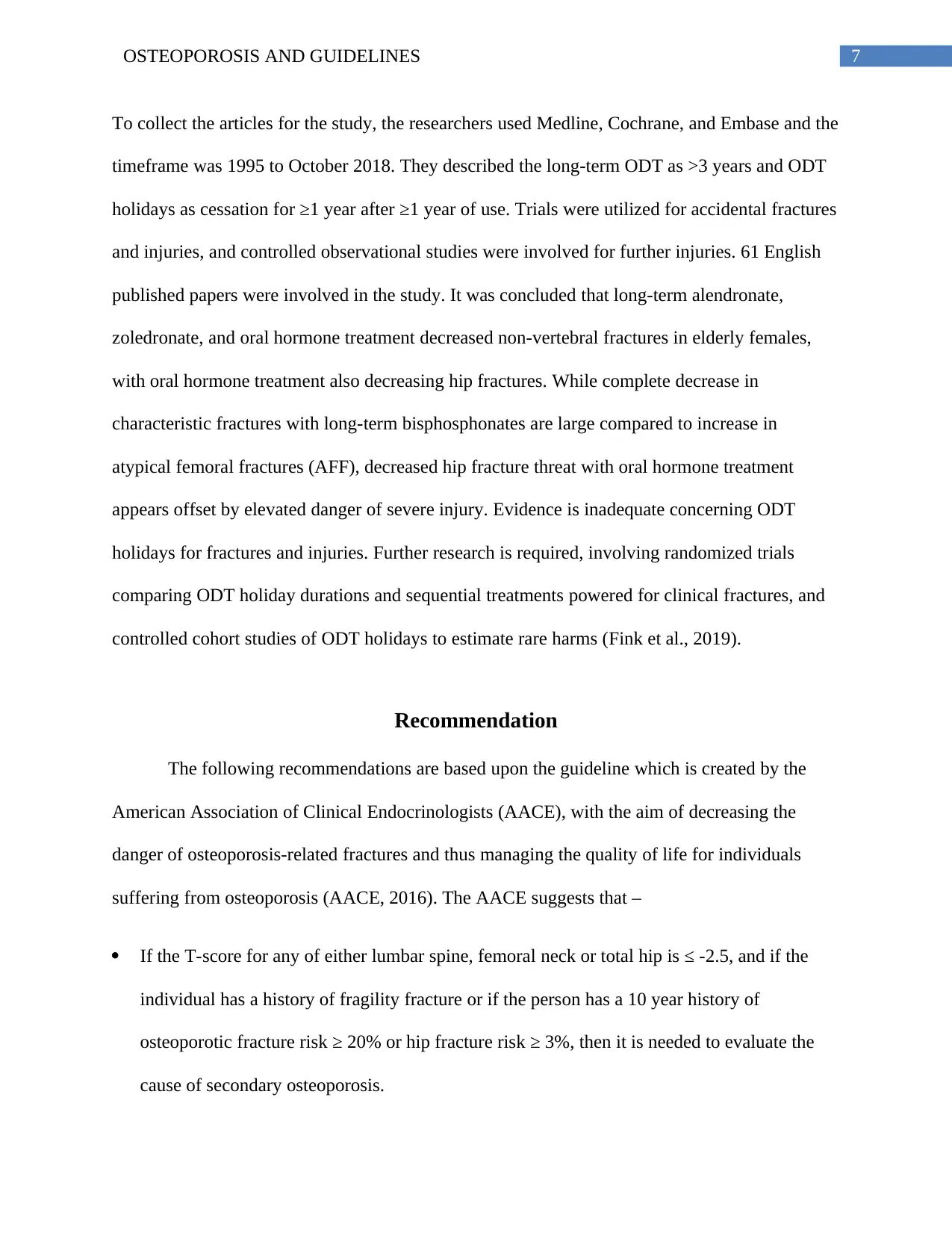
7OSTEOPOROSIS AND GUIDELINES
To collect the articles for the study, the researchers used Medline, Cochrane, and Embase and the
timeframe was 1995 to October 2018. They described the long-term ODT as >3 years and ODT
holidays as cessation for ≥1 year after ≥1 year of use. Trials were utilized for accidental fractures
and injuries, and controlled observational studies were involved for further injuries. 61 English
published papers were involved in the study. It was concluded that long-term alendronate,
zoledronate, and oral hormone treatment decreased non-vertebral fractures in elderly females,
with oral hormone treatment also decreasing hip fractures. While complete decrease in
characteristic fractures with long-term bisphosphonates are large compared to increase in
atypical femoral fractures (AFF), decreased hip fracture threat with oral hormone treatment
appears offset by elevated danger of severe injury. Evidence is inadequate concerning ODT
holidays for fractures and injuries. Further research is required, involving randomized trials
comparing ODT holiday durations and sequential treatments powered for clinical fractures, and
controlled cohort studies of ODT holidays to estimate rare harms (Fink et al., 2019).
Recommendation
The following recommendations are based upon the guideline which is created by the
American Association of Clinical Endocrinologists (AACE), with the aim of decreasing the
danger of osteoporosis-related fractures and thus managing the quality of life for individuals
suffering from osteoporosis (AACE, 2016). The AACE suggests that –
If the T-score for any of either lumbar spine, femoral neck or total hip is ≤ -2.5, and if the
individual has a history of fragility fracture or if the person has a 10 year history of
osteoporotic fracture risk ≥ 20% or hip fracture risk ≥ 3%, then it is needed to evaluate the
cause of secondary osteoporosis.
To collect the articles for the study, the researchers used Medline, Cochrane, and Embase and the
timeframe was 1995 to October 2018. They described the long-term ODT as >3 years and ODT
holidays as cessation for ≥1 year after ≥1 year of use. Trials were utilized for accidental fractures
and injuries, and controlled observational studies were involved for further injuries. 61 English
published papers were involved in the study. It was concluded that long-term alendronate,
zoledronate, and oral hormone treatment decreased non-vertebral fractures in elderly females,
with oral hormone treatment also decreasing hip fractures. While complete decrease in
characteristic fractures with long-term bisphosphonates are large compared to increase in
atypical femoral fractures (AFF), decreased hip fracture threat with oral hormone treatment
appears offset by elevated danger of severe injury. Evidence is inadequate concerning ODT
holidays for fractures and injuries. Further research is required, involving randomized trials
comparing ODT holiday durations and sequential treatments powered for clinical fractures, and
controlled cohort studies of ODT holidays to estimate rare harms (Fink et al., 2019).
Recommendation
The following recommendations are based upon the guideline which is created by the
American Association of Clinical Endocrinologists (AACE), with the aim of decreasing the
danger of osteoporosis-related fractures and thus managing the quality of life for individuals
suffering from osteoporosis (AACE, 2016). The AACE suggests that –
If the T-score for any of either lumbar spine, femoral neck or total hip is ≤ -2.5, and if the
individual has a history of fragility fracture or if the person has a 10 year history of
osteoporotic fracture risk ≥ 20% or hip fracture risk ≥ 3%, then it is needed to evaluate the
cause of secondary osteoporosis.
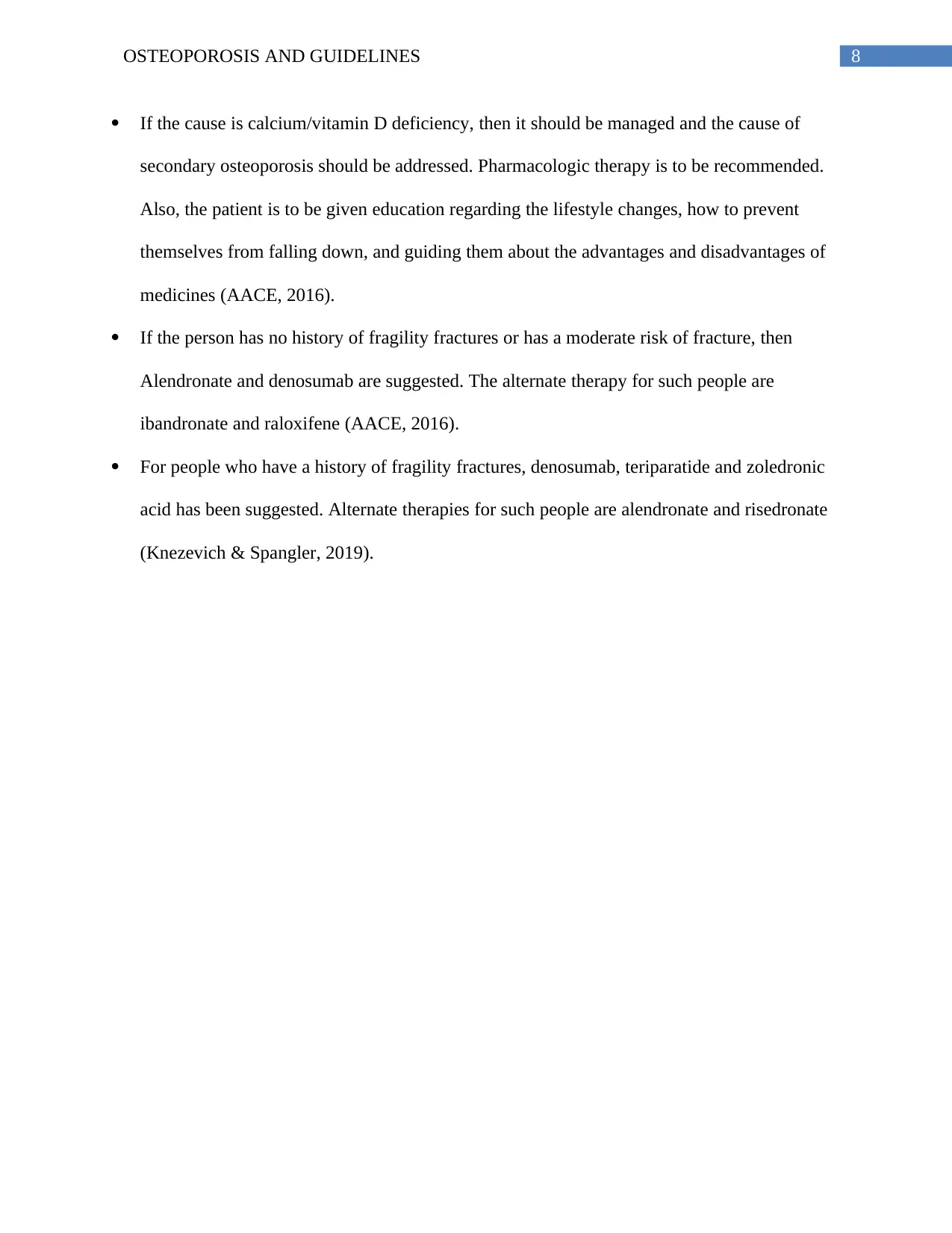
8OSTEOPOROSIS AND GUIDELINES
If the cause is calcium/vitamin D deficiency, then it should be managed and the cause of
secondary osteoporosis should be addressed. Pharmacologic therapy is to be recommended.
Also, the patient is to be given education regarding the lifestyle changes, how to prevent
themselves from falling down, and guiding them about the advantages and disadvantages of
medicines (AACE, 2016).
If the person has no history of fragility fractures or has a moderate risk of fracture, then
Alendronate and denosumab are suggested. The alternate therapy for such people are
ibandronate and raloxifene (AACE, 2016).
For people who have a history of fragility fractures, denosumab, teriparatide and zoledronic
acid has been suggested. Alternate therapies for such people are alendronate and risedronate
(Knezevich & Spangler, 2019).
If the cause is calcium/vitamin D deficiency, then it should be managed and the cause of
secondary osteoporosis should be addressed. Pharmacologic therapy is to be recommended.
Also, the patient is to be given education regarding the lifestyle changes, how to prevent
themselves from falling down, and guiding them about the advantages and disadvantages of
medicines (AACE, 2016).
If the person has no history of fragility fractures or has a moderate risk of fracture, then
Alendronate and denosumab are suggested. The alternate therapy for such people are
ibandronate and raloxifene (AACE, 2016).
For people who have a history of fragility fractures, denosumab, teriparatide and zoledronic
acid has been suggested. Alternate therapies for such people are alendronate and risedronate
(Knezevich & Spangler, 2019).
⊘ This is a preview!⊘
Do you want full access?
Subscribe today to unlock all pages.

Trusted by 1+ million students worldwide
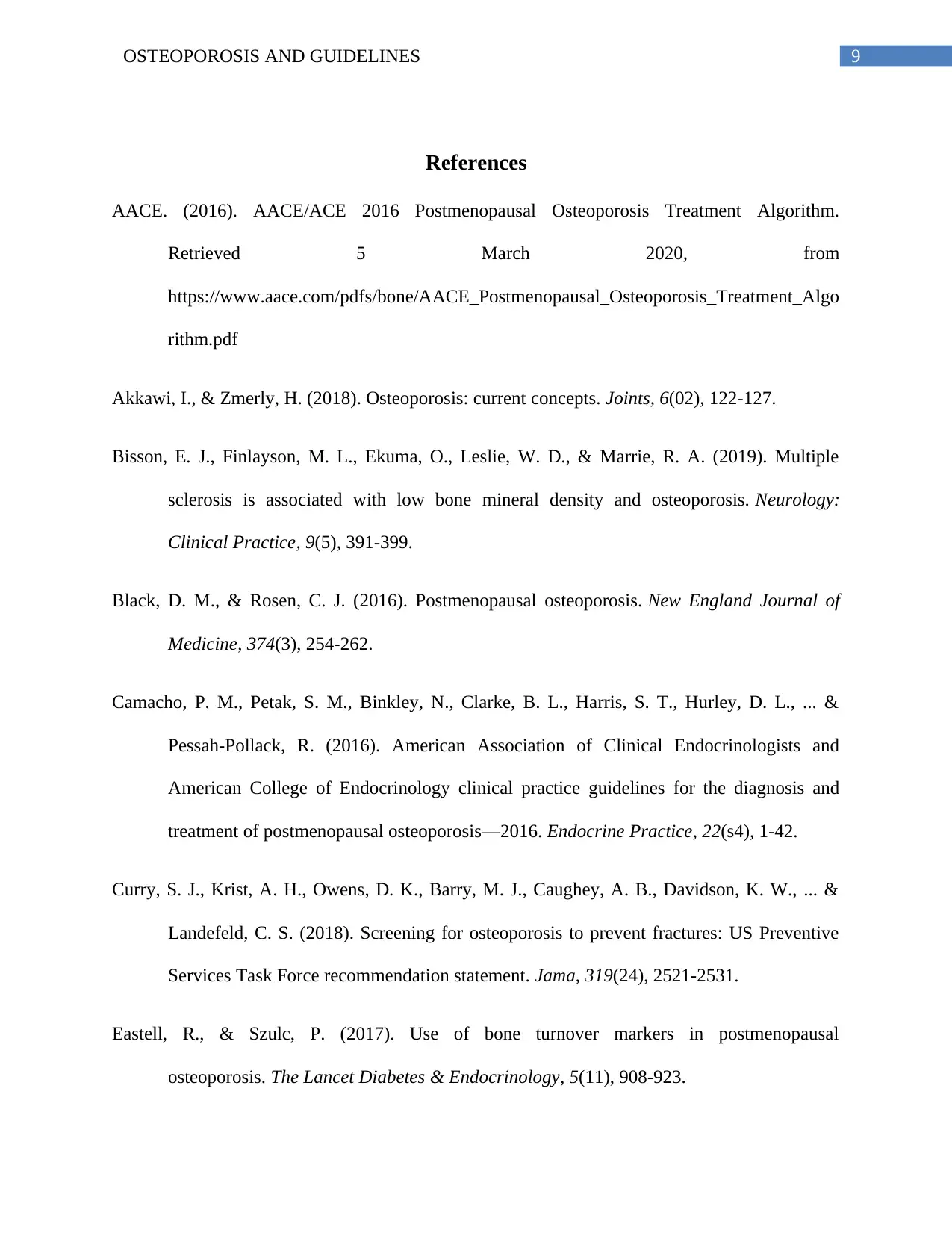
9OSTEOPOROSIS AND GUIDELINES
References
AACE. (2016). AACE/ACE 2016 Postmenopausal Osteoporosis Treatment Algorithm.
Retrieved 5 March 2020, from
https://www.aace.com/pdfs/bone/AACE_Postmenopausal_Osteoporosis_Treatment_Algo
rithm.pdf
Akkawi, I., & Zmerly, H. (2018). Osteoporosis: current concepts. Joints, 6(02), 122-127.
Bisson, E. J., Finlayson, M. L., Ekuma, O., Leslie, W. D., & Marrie, R. A. (2019). Multiple
sclerosis is associated with low bone mineral density and osteoporosis. Neurology:
Clinical Practice, 9(5), 391-399.
Black, D. M., & Rosen, C. J. (2016). Postmenopausal osteoporosis. New England Journal of
Medicine, 374(3), 254-262.
Camacho, P. M., Petak, S. M., Binkley, N., Clarke, B. L., Harris, S. T., Hurley, D. L., ... &
Pessah-Pollack, R. (2016). American Association of Clinical Endocrinologists and
American College of Endocrinology clinical practice guidelines for the diagnosis and
treatment of postmenopausal osteoporosis—2016. Endocrine Practice, 22(s4), 1-42.
Curry, S. J., Krist, A. H., Owens, D. K., Barry, M. J., Caughey, A. B., Davidson, K. W., ... &
Landefeld, C. S. (2018). Screening for osteoporosis to prevent fractures: US Preventive
Services Task Force recommendation statement. Jama, 319(24), 2521-2531.
Eastell, R., & Szulc, P. (2017). Use of bone turnover markers in postmenopausal
osteoporosis. The Lancet Diabetes & Endocrinology, 5(11), 908-923.
References
AACE. (2016). AACE/ACE 2016 Postmenopausal Osteoporosis Treatment Algorithm.
Retrieved 5 March 2020, from
https://www.aace.com/pdfs/bone/AACE_Postmenopausal_Osteoporosis_Treatment_Algo
rithm.pdf
Akkawi, I., & Zmerly, H. (2018). Osteoporosis: current concepts. Joints, 6(02), 122-127.
Bisson, E. J., Finlayson, M. L., Ekuma, O., Leslie, W. D., & Marrie, R. A. (2019). Multiple
sclerosis is associated with low bone mineral density and osteoporosis. Neurology:
Clinical Practice, 9(5), 391-399.
Black, D. M., & Rosen, C. J. (2016). Postmenopausal osteoporosis. New England Journal of
Medicine, 374(3), 254-262.
Camacho, P. M., Petak, S. M., Binkley, N., Clarke, B. L., Harris, S. T., Hurley, D. L., ... &
Pessah-Pollack, R. (2016). American Association of Clinical Endocrinologists and
American College of Endocrinology clinical practice guidelines for the diagnosis and
treatment of postmenopausal osteoporosis—2016. Endocrine Practice, 22(s4), 1-42.
Curry, S. J., Krist, A. H., Owens, D. K., Barry, M. J., Caughey, A. B., Davidson, K. W., ... &
Landefeld, C. S. (2018). Screening for osteoporosis to prevent fractures: US Preventive
Services Task Force recommendation statement. Jama, 319(24), 2521-2531.
Eastell, R., & Szulc, P. (2017). Use of bone turnover markers in postmenopausal
osteoporosis. The Lancet Diabetes & Endocrinology, 5(11), 908-923.
Paraphrase This Document
Need a fresh take? Get an instant paraphrase of this document with our AI Paraphraser
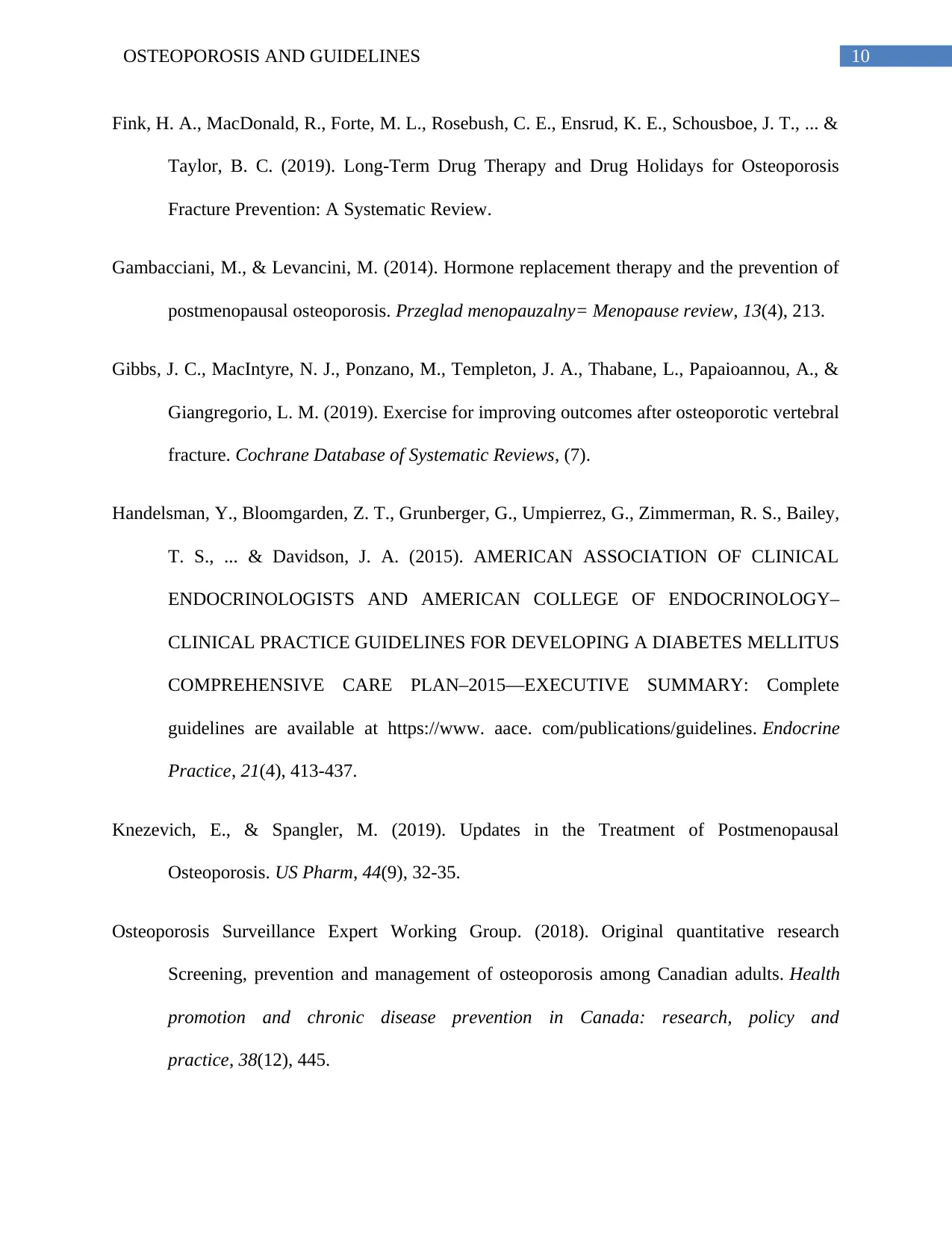
10OSTEOPOROSIS AND GUIDELINES
Fink, H. A., MacDonald, R., Forte, M. L., Rosebush, C. E., Ensrud, K. E., Schousboe, J. T., ... &
Taylor, B. C. (2019). Long-Term Drug Therapy and Drug Holidays for Osteoporosis
Fracture Prevention: A Systematic Review.
Gambacciani, M., & Levancini, M. (2014). Hormone replacement therapy and the prevention of
postmenopausal osteoporosis. Przeglad menopauzalny= Menopause review, 13(4), 213.
Gibbs, J. C., MacIntyre, N. J., Ponzano, M., Templeton, J. A., Thabane, L., Papaioannou, A., &
Giangregorio, L. M. (2019). Exercise for improving outcomes after osteoporotic vertebral
fracture. Cochrane Database of Systematic Reviews, (7).
Handelsman, Y., Bloomgarden, Z. T., Grunberger, G., Umpierrez, G., Zimmerman, R. S., Bailey,
T. S., ... & Davidson, J. A. (2015). AMERICAN ASSOCIATION OF CLINICAL
ENDOCRINOLOGISTS AND AMERICAN COLLEGE OF ENDOCRINOLOGY–
CLINICAL PRACTICE GUIDELINES FOR DEVELOPING A DIABETES MELLITUS
COMPREHENSIVE CARE PLAN–2015—EXECUTIVE SUMMARY: Complete
guidelines are available at https://www. aace. com/publications/guidelines. Endocrine
Practice, 21(4), 413-437.
Knezevich, E., & Spangler, M. (2019). Updates in the Treatment of Postmenopausal
Osteoporosis. US Pharm, 44(9), 32-35.
Osteoporosis Surveillance Expert Working Group. (2018). Original quantitative research
Screening, prevention and management of osteoporosis among Canadian adults. Health
promotion and chronic disease prevention in Canada: research, policy and
practice, 38(12), 445.
Fink, H. A., MacDonald, R., Forte, M. L., Rosebush, C. E., Ensrud, K. E., Schousboe, J. T., ... &
Taylor, B. C. (2019). Long-Term Drug Therapy and Drug Holidays for Osteoporosis
Fracture Prevention: A Systematic Review.
Gambacciani, M., & Levancini, M. (2014). Hormone replacement therapy and the prevention of
postmenopausal osteoporosis. Przeglad menopauzalny= Menopause review, 13(4), 213.
Gibbs, J. C., MacIntyre, N. J., Ponzano, M., Templeton, J. A., Thabane, L., Papaioannou, A., &
Giangregorio, L. M. (2019). Exercise for improving outcomes after osteoporotic vertebral
fracture. Cochrane Database of Systematic Reviews, (7).
Handelsman, Y., Bloomgarden, Z. T., Grunberger, G., Umpierrez, G., Zimmerman, R. S., Bailey,
T. S., ... & Davidson, J. A. (2015). AMERICAN ASSOCIATION OF CLINICAL
ENDOCRINOLOGISTS AND AMERICAN COLLEGE OF ENDOCRINOLOGY–
CLINICAL PRACTICE GUIDELINES FOR DEVELOPING A DIABETES MELLITUS
COMPREHENSIVE CARE PLAN–2015—EXECUTIVE SUMMARY: Complete
guidelines are available at https://www. aace. com/publications/guidelines. Endocrine
Practice, 21(4), 413-437.
Knezevich, E., & Spangler, M. (2019). Updates in the Treatment of Postmenopausal
Osteoporosis. US Pharm, 44(9), 32-35.
Osteoporosis Surveillance Expert Working Group. (2018). Original quantitative research
Screening, prevention and management of osteoporosis among Canadian adults. Health
promotion and chronic disease prevention in Canada: research, policy and
practice, 38(12), 445.
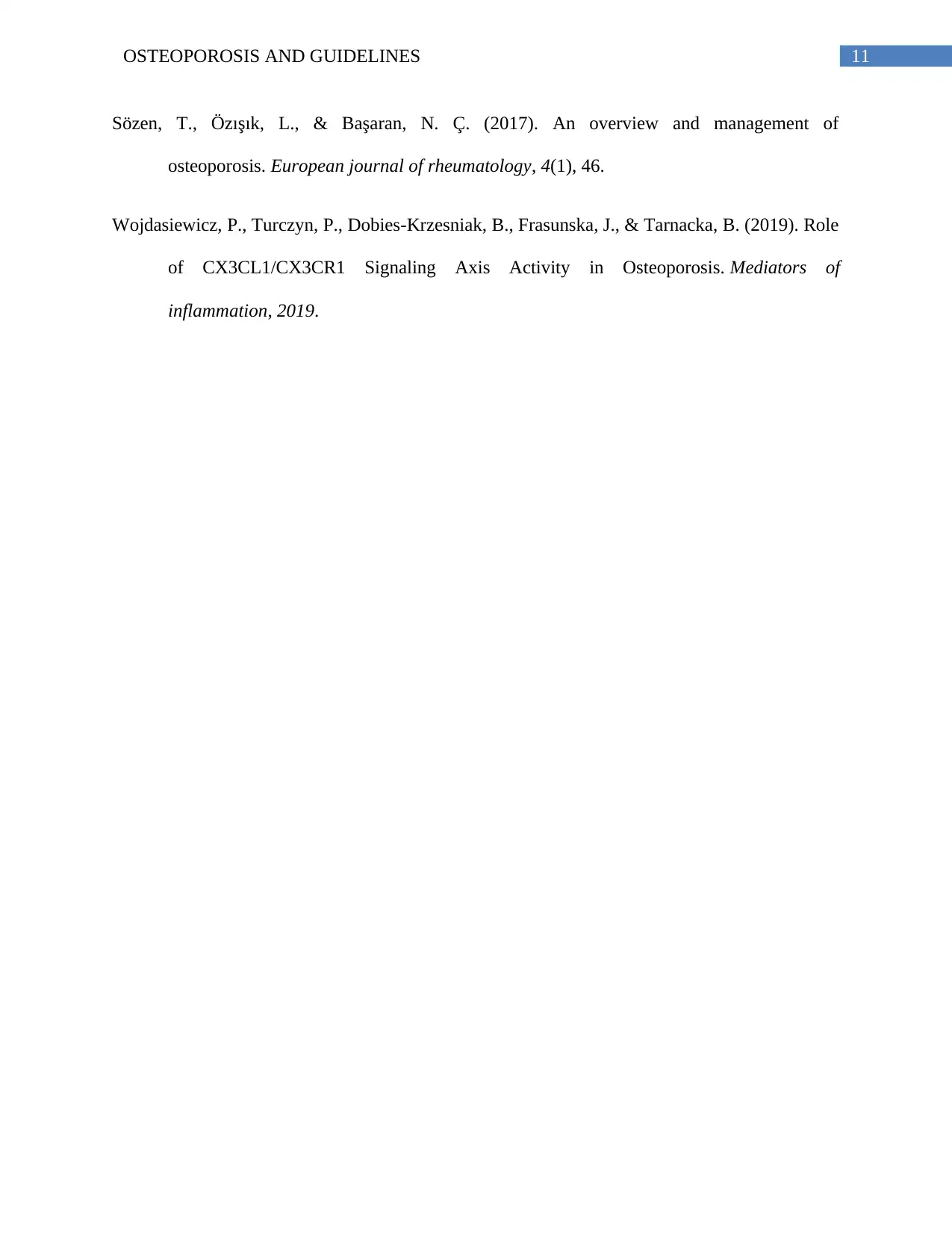
11OSTEOPOROSIS AND GUIDELINES
Sözen, T., Özışık, L., & Başaran, N. Ç. (2017). An overview and management of
osteoporosis. European journal of rheumatology, 4(1), 46.
Wojdasiewicz, P., Turczyn, P., Dobies-Krzesniak, B., Frasunska, J., & Tarnacka, B. (2019). Role
of CX3CL1/CX3CR1 Signaling Axis Activity in Osteoporosis. Mediators of
inflammation, 2019.
Sözen, T., Özışık, L., & Başaran, N. Ç. (2017). An overview and management of
osteoporosis. European journal of rheumatology, 4(1), 46.
Wojdasiewicz, P., Turczyn, P., Dobies-Krzesniak, B., Frasunska, J., & Tarnacka, B. (2019). Role
of CX3CL1/CX3CR1 Signaling Axis Activity in Osteoporosis. Mediators of
inflammation, 2019.
⊘ This is a preview!⊘
Do you want full access?
Subscribe today to unlock all pages.

Trusted by 1+ million students worldwide
1 out of 12
Related Documents
Your All-in-One AI-Powered Toolkit for Academic Success.
+13062052269
info@desklib.com
Available 24*7 on WhatsApp / Email
![[object Object]](/_next/static/media/star-bottom.7253800d.svg)
Unlock your academic potential
Copyright © 2020–2025 A2Z Services. All Rights Reserved. Developed and managed by ZUCOL.





